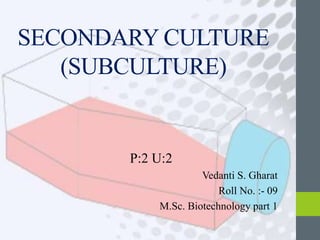Secondary culture.pptx
Secondary culture refers to culturing cells from a primary culture in new media after the primary culture reaches confluence. This results in a more homogeneous cell line compared to the heterogeneous primary culture. Subculturing is important for propagating and characterizing cell lines and opening up experimental possibilities. A cell line becomes a cell strain if a specific cell lineage is selected through cloning or other techniques. Subculturing follows a standard pattern of a lag period, exponential growth phase, and cessation of growth once the substrate is occupied, requiring changing of media or dividing the culture. Criteria for subculturing a monolayer include the density and confluence of the culture, exhaustion of media, time since last subculture, and requirements

Recommended
Recommended
More Related Content
What's hot
What's hot (20)
Similar to Secondary culture.pptx
Similar to Secondary culture.pptx (20)
More from Ved Gharat
More from Ved Gharat (20)
Recently uploaded
Recently uploaded (20)
Secondary culture.pptx
- 1. SECONDARY CULTURE (SUBCULTURE) P:2 U:2 Vedanti S. Gharat Roll No. :- 09 M.Sc. Biotechnology part 1
- 2. SECONDARY CULTURE • When cells from primary culture reach confluence and are isolated followed by culturing in new media that culture is called secondary culture. • From a very heterogeneous primary culture, containing many of the cell types present in the original tissue, a more homogeneous cell line emerges. • In addition to its biological significance, this process has considerable practical importance, as the culture can now be propagated, characterized, and stored, and the potential increase in cell number and the uniformity of the cells open up a much wider range of experimental possibilities.
- 4. • Once a primary culture is subcultured (or passaged), it becomes known as a cell line. • If one cell lineage is selected, by cloning, by physical cell separation, or by any other selection technique, to have certain specific properties that have been identified in the bulk of the cells in the culture, this cell line becomes known as a cell strain. • If a cell line transforms in vitro, it gives rise to a continuous cell line, and if selected or cloned and characterized, it is known as a continuous cell strain. • It is vital at this stage to confirm the identity of the cell lines and exclude the possibility of cross-contamination. • The first subculture gives rise to a secondary culture, the secondary to a tertiary, and so on.
- 5. SUBCLUTURE • When a cell line is subcultured, the regrowth of the cells to a point ready for the next subculture usually follows a standard pattern. • A lag period after seeding is followed by a period of exponential growth, called the log phase. • When the cell density reaches a level such that all of the available substrate is occupied, or when the cell concentration exceeds the capacity of the medium, growth ceases or is greatly reduced. • Then either the medium must be changed more frequently or the culture must be divided. • For an adherent cell line, dividing a culture, or subculture as it is called, usually involves removal of the medium and dissociation of the cells in the monolayer with trypsin, although some loosely adherent cells may be subcultured by shaking the bottle, collecting the cells in the medium, and diluting as appropriate in fresh medium in new bottles.
- 7. CRITERIAFOR SUBCULTURE • The need to subculture a monolayer is determined by the following criteria: (1) Density of culture. • Normal cells should be subcultured as soon as they reach confluence. • If left more than 24 h beyond this point, they will withdraw from the cycle and take longer to recover when reseeded. • Transformed cells should also be subcultured on reaching confluence or shortly after. (2) Exhaustion of medium. • Exhaustion of the medium usually indicates that the medium requires replacement, but if a fall in pH occurs so rapidly that the medium must be changed more frequently, then subculture may be required.
- 8. (3) Time since last subculture. • Routine subculture is best performed according to a strict schedule, so that reproducible behavior is achieved and monitored. • If cells have not reached a high enough density (i.e., they are not confluent) by the appropriate time, then increase the seeding density, or if they reach confluence too soon, then reduce the seeding density. • A cell concentration should be found that allows for the cells to be subcultured after 7 days, with the medium being changed after 4 days. (4) Requirements for other procedures. • When cells are required for purposes other than routine propagation, they also have to be subcultured in order to increase the stock or to change the type of culture vessel or medium. • Ideally this procedure is done at the regular subculture time, when it is known that the culture is performing routinely, what the reseeding conditions are, and what outcome can be expected.
- 9. Handling different cell lines. • Different cell lines should be handled separately, with a separate set of media and reagents. • If they are all handled at the same time, there is a significant risk of cross-contamination. Labeling. • Always label flasks and other culture vessels before cells are added to help prevent misidentification. • Labeling should be on the side of a flask so that viewing on the microscope is not impaired, and on the edge of the base of a Petri dish or multiwell plate. NEED FOR SUBCULTURE
- 10. Typical Subculture Protocol for Cells Grown as a Monolayer
- 11. REFERENCES:- • Culture of animal cells book by R. Ian Freshney. • Images from Google.